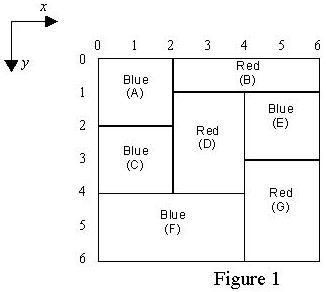poj_1691 Painting A Board(dfs+拓扑)
来源:互联网 发布:分类信息网站源码 编辑:程序博客网 时间:2024/06/05 05:30
Painting A Board
Time Limit: 1000MS Memory Limit: 10000KTotal Submissions: 3797 Accepted: 1879
Description
The CE digital company has built an Automatic Painting Machine (APM) to paint a flat board fully covered by adjacent non-overlapping rectangles of different sizes each with a predefined color.

To color the board, the APM has access to a set of brushes. Each brush has a distinct color C. The APM picks one brush with color C and paints all possible rectangles having predefined color C with the following restrictions:
To avoid leaking the paints and mixing colors, a rectangle can only be painted if all rectangles immediately above it have already been painted. For example rectangle labeled F in Figure 1 is painted only after rectangles C and D are painted. Note that each rectangle must be painted at once, i.e. partial painting of one rectangle is not allowed.
You are to write a program for APM to paint a given board so that the number of brush pick-ups is minimum. Notice that if one brush is picked up more than once, all pick-ups are counted.

To color the board, the APM has access to a set of brushes. Each brush has a distinct color C. The APM picks one brush with color C and paints all possible rectangles having predefined color C with the following restrictions:
To avoid leaking the paints and mixing colors, a rectangle can only be painted if all rectangles immediately above it have already been painted. For example rectangle labeled F in Figure 1 is painted only after rectangles C and D are painted. Note that each rectangle must be painted at once, i.e. partial painting of one rectangle is not allowed.
You are to write a program for APM to paint a given board so that the number of brush pick-ups is minimum. Notice that if one brush is picked up more than once, all pick-ups are counted.
Input
The first line of the input file contains an integer M which is the number of test cases to solve (1 <= M <= 10). For each test case, the first line contains an integer N, the number of rectangles, followed by N lines describing the rectangles. Each rectangle R is specified by 5 integers in one line: the y and x coordinates of the upper left corner of R, the y and x coordinates of the lower right corner of R, followed by the color-code of R.
Note that:
Note that:
- Color-code is an integer in the range of 1 .. 20.
- Upper left corner of the board coordinates is always (0,0).
- Coordinates are in the range of 0 .. 99.
- N is in the range of 1..15.
Output
One line for each test case showing the minimum number of brush pick-ups.
Sample Input
170 0 2 2 10 2 1 6 22 0 4 2 11 2 4 4 21 4 3 6 14 0 6 4 13 4 6 6 2
Sample Output
3
将矩形设为顶点,若矩形i有紧贴着下边缘的矩形j,则i到j连一条有向边,这样很明显就是按拓扑序涂色了。
直接暴力就能过,想了一下,数据量不大,用一个整数来表示目前矩形涂色与否的状态,然后根据状态与目前刷子的颜色来记忆化搜索应该可行。
#include <iostream>#include <cstdio>#include <cstdlib>#include <cstring>#include <cmath>#include <stack>#include <bitset>#include <queue>#include <set>#include <map>#include <string>#include <algorithm>#define FOP freopen("data.txt","r",stdin)#define FOP2 freopen("data1.txt","w",stdout)#define inf 0x3f3f3f3f#define maxn 22#define mod 1000000007#define PI acos(-1.0)#define LL long longusing namespace std;struct Node{ int x1, y1, x2, y2, color, indegree; bool flag; Node(int _x1, int _y1, int _x2, int _y2, int _color) : x1(_x1), y1(_y1), x2(_x2), y2(_y2), color(_color) { indegree = 0, flag = 0; }};struct Edge{ int from, to; Edge(int u, int v) : from(u), to(v) {}};int n, m;vector<int> G[maxn];vector<Edge> edges;int ans;vector<Node> nodes;void init(){ ans = inf; for(int i = 1; i <= n; i++) G[i].clear(); edges.clear(); nodes.clear();}void AddEdge(int from, int to){ edges.push_back(Edge(from, to)); m = edges.size(); G[from].push_back(m-1);}void dfs(int nn, int col, int cot){ if(cot >= ans) return ; //剪枝 if(nn == n) { if(ans > cot) ans = cot; return ; } for(int i = 1; i <= n; i++) { if(!nodes[i].flag && nodes[i].indegree == 0) { nodes[i].flag = 1; for(int j = 0; j < G[i].size(); j++) { Edge &e = edges[G[i][j]]; nodes[e.to].indegree--; } if(nodes[i].color != col) dfs(nn+1, nodes[i].color, cot+1); else dfs(nn+1, col, cot); nodes[i].flag = 0; for(int j = 0; j < G[i].size(); j++) { Edge &e = edges[G[i][j]]; nodes[e.to].indegree++; } } }}int main(){ int T; scanf("%d", &T); while(T--) { init(); scanf("%d", &n); int x1, x2, y1, y2, color; nodes.push_back(Node(0, 0, 0, 0, 0)); for(int i = 1; i <= n; i++) { scanf("%d%d%d%d%d", &y1, &x1, &y2, &x2, &color); nodes.push_back(Node(x1, y1, x2, y2, color)); } for(int i = 1; i <= n; i++) { for(int j = 1; j <= n; j++) { if(i == j) continue; if(nodes[i].y2 == nodes[j].y1 && nodes[i].x2 > nodes[j].x1 && nodes[i].x1 < nodes[j].x2) { AddEdge(i, j); nodes[j].indegree++; } } } dfs(0, 0, 0); printf("%d\n", ans); } return 0;}
0 0
- poj_1691 Painting A Board(dfs+拓扑)
- poj1691 Painting A Board(DFS+拓扑)
- poj1691--Painting A Board(拓扑+dfs)
- Painting A Board----DFS
- poj 1691 Painting A Board (拓扑排序+dfs)
- poj 1691 Painting A Board(dfs,拓扑排序)
- poj 1691 Painting A Board 拓扑序+dfs
- [poj 1691] Painting A Board dfs+拓扑排序
- 【POJ 1691】 Painting A Board(dfs)
- POJ 1691 Painting A Board(dfs搜索)
- POJ 题目1691 Painting A Board(DFS)
- (POJ 1691)Painting A Board <top序列 + DFS>
- [POJ 1691]Painting A Board[DFS][排序]
- poj 1691 Painting A Board (构图 DFS)
- POJ1691 Painting A Board ACM解题报告(DFS+构造)难题=。=
- pku 1691 painting a board dfs+回溯 解题报告
- POJ 1691 Painting A Board (DFS/状态DP)
- Painting A Board(状压dp)
- CCS3属性之text-overflow:ellipsis;的用法和注意之处
- ASP.NET MVC中的Global.asax文件
- php使用GD库
- MySQL--数据库操作
- thinkphp3.2+bootstrap-inputfile多文件上传
- poj_1691 Painting A Board(dfs+拓扑)
- Runtime
- 各种技术基础研究(小计划)
- Apache Beam
- iframe横向滚动条的问题
- 过滤器filters
- html5(一)基础
- 判断窗口高度
- sql防止注入的方法


